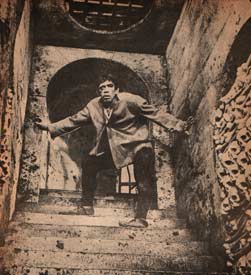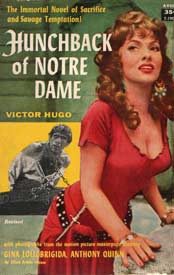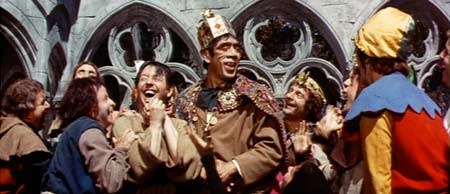
![]()
edited by John Hayes
The Forgotten Hunchback
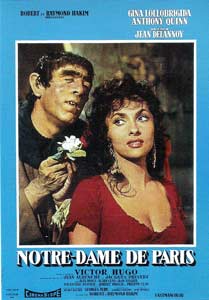 |
Ask most most people who they remember as Quasimodo, and I would guess that most of them would say Charles Laughton from William Dieterle's 1937 production for RKO. It was certainly a memorable interpretation and it inspired generations of schoolboys to hop around the schoolyard, chanting "the bells, the bells..." (we've all done it). And before that there there was the immortal Lon Chaney's silent version from 1923 - with the 56 pound hump and leather strapping to keep him bent double, not for the first - or last - time suffering for his art. There had been another Quasimodo, even before Chaney's, when Henry Krauss took his turn as the bell-ringer of Notre Dame, as far back as 1911 in France. And now, of course, today's generation only know Quasimodo as a singing cartoon character, courtesy of the Mouse Factory.
But for me, there is only one Quasimodo: Anthony Quinn. I can still remember rushing down the street to our local cinema - The Palace, in Heywood - one night in 1957 to see the Hunchback Of Notre Dame; I'd seen the trailer the previous week, and could hardly wait. Certain films in those days could make a tremendous impression on me and scenes from some of them - and the effect they had on me at the time - have, thankfully, never been forgotten, so I can recall clearly the butterflies in the stomach and the chill down the spine as the curtains opened on the CinemaScope screen and the great bell of Notre Dame began to slowly swing back and forth behind the credits, booming into the auditorium as the title music (by Georges Auric) swelled in time.
I guess I must have seen Quinn in dozens of films by the time I saw Hunchback, but I'd never really been aware of him. He'd just won his second Oscar for Lust For Life, but I'd never heard of it (be fair, I was only nine ). All that changed when I saw him play Quasimodo. I was transfixed. Alternately terrified and moved almost to tears by this shambling, deformed creature, I became utterly involved in the movie reality of 15th century Paris, and The Hunchback Of Notre Dame became one of my 'Desert Island Movies' for all time.
|
Anthony Quinn as Quasimodo in |
It was actually a French/Italian production of the brothers Robert and Raymond Hakim, Egyptian entrepreneurs who had been co-producing movies since the thirties. Essentially a vehicle designed to take advantage of Gina Lollobrigida's then status as Italy's number one female star, she had top billing, but she was insistent that Anthony Quinn be cast as Quasimodo. Even when Quinn suffered a severe, disfiguring allergic reaction to something he had eaten on the sea voyage to Europe and was unable to work for several weeks, she would consider no other actor for the part. Shot between 16th April and 11th August 1956 at The Paris Cinema Studios and the Studio de Boulogne, The Hunchback Of Notre Dame had a largely French cast and crew, with the director, Jean Delannoy providing brisk, well-paced direction and showing a good eye for spectacle. Sumptuous Eastmancolor photography by Michel Kleber brings production designer Rene Renoux's fabulous sets to vivid life.
The two leads are perfectly cast as Esmeralda and Quasimodo. Lollobrigida, with her normally pale complexion darkened for the role of Esmeralda, is the very epitome of the wild, sensual but pure, gipsy dancer. Born Luigina Lollobrigida in Subiaco, Italy, she was the daughter of a furniture manufacturer. In 1946 she came third in a beauty competition (behind Lucia Bose and Gianna Maria Canale) which led to her appearing in her debut feature, Aquila Nera. More film roles followed with increasing success, until her 'breakthrough' part as Marie Dannreuther, opposite Humphrey Bogart in John Huston's 1953 film, Beat The Devil. Prior to her role as Esmeralda, she had just completed the highly successful Trapeze, with Burt Lancaster and Tony Curtis. She would go on to appear in many hugely popular films which would embrace a wide variety of genres, and in which she would seem completely at ease. From the epic Solomon And Sheba (1961) to the romantic comedies with Rock Hudson: Come September (1964) and Strange Bedfellows (1966). From psychological thrillers like Woman Of Straw (1965) to the highly entertaining Buona Sera, Mrs Campbell 1972). From the Seventies on, her screen appearances became fewer, as she bagan a successful second career as a photographer, and also became a corporate executive for a fashion and cosmetics company. Gina will alo be remembered for her appearances in the TV series Falcon Crest, during the Eighties.
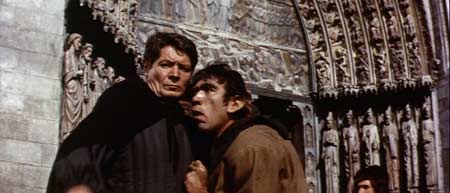 |
Unusually, for an actor so identified with powerful character roles, Anthony Quinn brought a child-like quality to the role of the loyal Quasimodo, giving the character, by turns, a sense of bewilderment, loneliness, confusion and ultimately (and unforgettably), unbearable pain as the Hunchback sees the lifeless body of Esmeralda dragged from the cathedral and cries out in anger and despair. The six-foot two-inch actor was born Antonio Rudolfo Oaxaca Quinn. Son of an Irish Father and Mexican mother, he grew up in East LA and had a chequered employment career as a butcher, prizefighter and street corner preacher. He was even awarded a scholarship to study architecture under Frank Lloyd Wright, with whom he would develop a close relationship, before eventually breaking into films in 1936. Early roles, playing mostly gangsters and indians, led to a signing for Paramount, where he appeared in The Plainsman for Cecil B. DeMille (whose daughter Katherine he married the following year), and The Buccaneer. Moving to Warner Bros. and 20th Century-Fox would see him appearing in bigger, more expensive productions, such as City For Conquest and They Died With Their Boots On. In 1952 he would win his first Oscar as the brother of Mexican revolutionary, Zapata (Marlon Brando) in Viva Zapata! In 1954 he won acclaim for his role as the brutish strongman in Fellini's Oscar-winning film, La Strada. Two roles with Kirk Douglas in Ulysses (1955) and Lust For Life - actually an eight-minute cameo - (1956) led to his second Oscar for the latter. The Sixties brought many memorable parts for Quinn, in such notable films as Barabbas, The Guns Of Navarone, Behold A Pale Horse, A High Wind In Jamaica, Zorba The Greek and Lawrence Of Arabia, to name but a few. From the Seventies on, the quality of the films in which he appeared began to decline - although his performances in even the bad ones were still memorable. Anthony Quinn died on 3rd June 2001.
|
Cover of the Avon paperback |
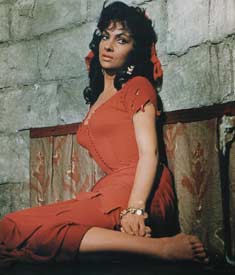 |
The Hunchback Of Notre Dame was released in France and Italy on the 19th December 1956, and on 1st April the following year in the United Kingdom. The film was a success in spite of a lukewarm reception by the critics. Picturegoer had this to say:
It's easy to see why two stars would find this old Victor Hugo classic so irresistable. For an actress there's fire, passion and poetry in the role of the shapely gipsy dancer, beloved by the thieves and beggars of Paris. Gina Lollobrigida has a wonderful time with the part.
For an actor, the sensitive hunchback with a heart of gold is a gorgeous wallow of a role. Anthony Quinn has a wonderful time, too.
|
Quasimodo is crowned King of Fools |
Picturegoers, however, may find this ponderous, architectural structure of a film something less than wonderful.
Masses of extras, gorgeous sets, exciting colour and an imaginative image of medieval Paris fail to make the old, old story come to life again. Perhaps the trouble is that it is an old story!
The gipsy, Esmeralda, beautiful and chaste, is desired by all men: not least by the wicked alchemist and his subservient helper, the hunchback.
The alchemist stabs one of her would-be lovers, Esmeralda is accused of the crime and sentenced to death as a witch. She is saved temporarily by the hunchback
Now and then the film catches the darkly ominous atmosphere of superstition and careless brutality of the Middle Ages. Mostly, though, it's just a top-heavy spectacle.
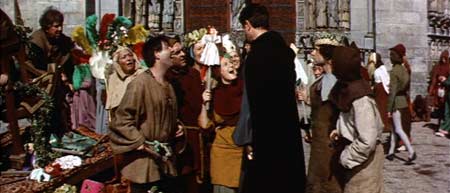 |
Most others were even less kind. The film dropped into relative obscurity following its inital release, appearing occasionally as a 'Sunday for One day Only' presentation in the days when they had such things. Rarely seen on TV, it remained neglected until it was miraculously rediscovered and restored in 2001. A 45th Anniversary Laserdisc, VHS tape and DVD soon followed. A print of the film was shown at The Moscow Film festival in June of this year, to much critical appreciation.
Sadly, you're still not likely to see The Hunchback Of Notre Dame at your local multplex any time soon; but thanks to Miramax we can now enjoy this underrated and long neglected classic in a pristine DVD transfer - in stereo surround, even!
The 1957 Hunchback Of Notre Dame is truly one of those films of which it can be said that they really don't make them like that anymore.
J.H.
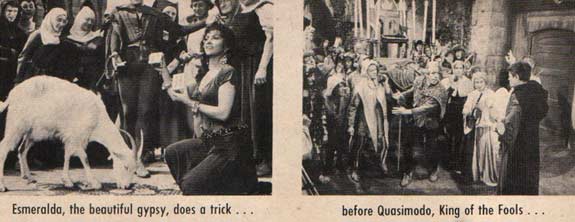 |
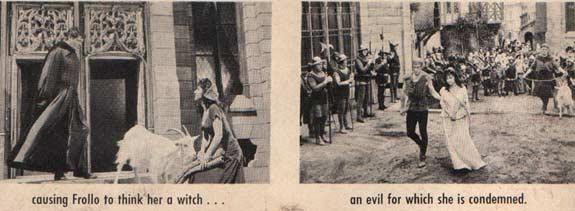 |
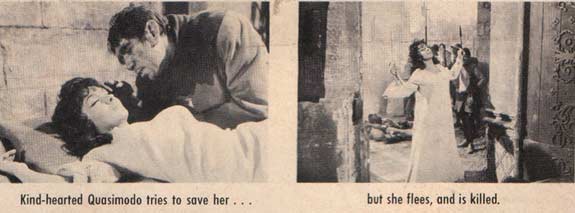 |
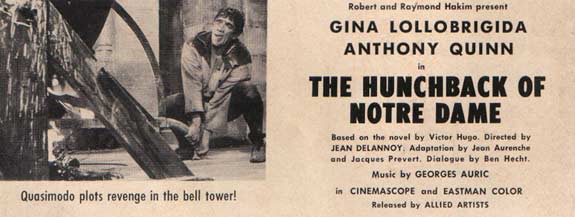 |
